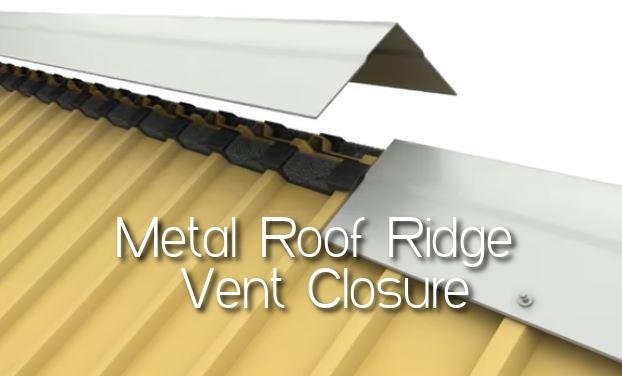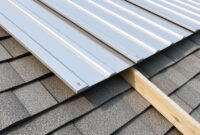Are you dealing with poor roof ventilation and attic damage? Many homeowners struggle with metal roof ridge vent systems that don’t work well. This can harm your home’s structure and energy use.
Without the right ridge vent closure, your roof faces moisture, temperature issues, and structural damage. I’ll show you how the right metal roof ridge vent can improve your roof’s performance.
Read also: Foam Closures for Metal Roofing
By looking at different ridge vent closure options, you’ll learn to keep your roof and attic healthy. My guide will give you the info you need to choose the best ventilation for your roof.

Understanding Metal Roof Ridge Vent Systems and Their Importance
Ridge vents are key to keeping your home safe. They help keep your attic healthy by stopping moisture and controlling temperature. Let’s look at what makes ridge vent systems important for homeowners.
Key Components of Roof Ridge Ventilation
A good attic ventilation system has a few important parts:
- Ridge vent openings along the roof’s peak
- Proper vent closure mechanisms
- Underlayment protection
- Air intake vents at the roof’s lower edges
How Ridge Vents Support Attic Health
Ridge vents do more than just open up. They help move warm, damp air out of your attic. This stops problems like mold, wood rot, and keeps your home cool.
- Reducing moisture-related mold growth
- Preventing wood rot in roof structures
- Balancing indoor temperature
- Extending the lifespan of roofing materials
Essential Functions of Vent Closure Systems
Metal roofing ridge vent closures keep your attic safe. They block out debris, insects, and weather. The right closure lets air in while keeping your attic protected.
Benefits of Installing Metal Roof Ridge Vent Closure
When I first learned about metal roof ridge vent closures, I was impressed. They offer many benefits for roof construction. These systems protect and improve your property in many ways.
The main benefits of a metal roof ridge include:
- Superior heat escape from attic spaces
- Comprehensive protection against snow and ice damage
- Significant reduction in energy consumption
- Enhanced overall roof ventilation
My research showed that roof ridge exhaust systems boost home energy efficiency. They ensure good air flow, preventing moisture buildup. This reduces the load on HVAC systems, leading to lower bills and a longer roof life.
Key performance benefits include:
- 40-year limited warranty coverage
- Minimal maintenance requirements
- Cost-effective long-term solution
- Improved indoor temperature regulation
Investing in a quality metal roof ridge vent closure system is wise. It offers better home protection, energy savings, and structural integrity. Keeping your home safe and efficient has never been easier.
Different Types of Ridge Vent Closure Materials
Choosing the right closure materials for your metal roof’s ventilation is key. I’ll show you the best options to keep your roof sealed and working well.

Foam Closure Strips: Flexible Protection
Ridge vent foam closure strips are a big help for metal roofs. They seal the roof panels well, stopping water and heat from getting in. Foam closure strips are great because they:
- Stand up to the weather well
- Fit many roof designs
- Are light and simple to put on
- Keep the roof cool
Metal Closure Systems: Durability Meets Performance
Metal closure systems give your roof strong protection. Made from top-notch materials, they look good with metal roofs and last a long time. They fit many roof types, like:
- ⅞” Corrugated roofing
- R Panel/PBR Panel
- Western Rib/7.2 Panel
- Standing seam roofing
Universal Ridge Vent Solutions
Universal ridge vent solutions are perfect for those who want flexibility. They work with many roofing types, giving your roof the best ventilation. They also protect against weather damage.
Read also: Roof Ridge Vent Pros Cons Before Installing It on Your Roof
Metal Roof Ridge Vent Installation Guidelines
Installing a metal roof ridge vent needs precision and attention to detail. I’ll guide you through the key steps for a proper install. This ensures your metal roofing is protected and improves attic ventilation.
Before starting, make sure you have these important tools and materials:
- Safety harness
- Measuring tape
- Metal roofing sealant
- Ridge vent material
- Protective gloves
For a successful roof ridge installation, create a 2-inch wide opening along the ridge line. It’s important to measure and mark this space carefully before cutting.
| Installation Step | Key Considerations |
|---|---|
| Surface Preparation | Clean metal roofing panel thoroughly |
| Ridge Opening | Create 2-inch wide ventilation gap |
| Vent Placement | Position 1″ up-slope from ridge cap edge |
| Sealant Application | Use metal-specific roofing sealant |
When installing a metal roof ridge vent, focus on proper alignment and sealing. Roll out the ProfileVent carefully along both sides of the ridge cap. This ensures a tight and secure fit that prevents water infiltration.
- Clean the metal roofing surface completely
- Mark and cut the 2-inch ridge opening
- Apply roofing sealant along the cut edge
- Position the ridge vent material
- Secure the ridge cap carefully
Professional tip: Always check local building codes and manufacturer guidelines for metal roofing ridge vent systems. Each roof is unique and may need specific installation techniques.
Cost Analysis of Ridge Vent Closure Solutions
Understanding the cost of metal roofing accessories is key for homeowners and contractors. The cost of roof ridge vent installations is a big factor in making decisions. I’ll explain the costs of ridge vent closure solutions to guide your investment.

Material Pricing Breakdown
A metal roof ridge vent costs about $3.00 per linear foot. For a typical home, this means spending $150 to $250. The price changes based on the roofing accessories you pick:
- Foam closure strips: Most economical option
- Metal closure systems: Mid-range pricing
- Universal ridge vent solutions: Slightly higher investment
Installation Cost Considerations
Labor costs for metal roofing are quite reasonable. Most roofers can install a ridge vent fast, keeping labor costs low. If you do it yourself, you could save even more.
Long-term Value Assessment
Investing in a good ridge vent closure for your metal roof is worth it in the long run. It saves on energy, prevents moisture damage, and makes your roof last longer. Think of ridge vent installation as a smart long-term investment, not just an initial cost.
| Roof Ridge Vent Type | Average Material Cost | Estimated Installation Time |
|---|---|---|
| Foam Closure Strips | $2.50 per linear foot | 2-3 hours |
| Metal Closure Systems | $3.50 per linear foot | 3-4 hours |
| Universal Ridge Vents | $4.00 per linear foot | 4-5 hours |
Common Problems and Maintenance Requirements
Keeping your metal roof ridge vent in good shape is key for a healthy attic. I’ve found a few common issues that can harm your attic ventilation system. It’s important to catch these problems early to avoid bigger damage.
The main problems with metal roof ridge vents are:
- Water getting in during heavy rain
- Pests getting in through small gaps
- Debris or animal nests blocking the vents
- Rust on the metal parts of the vent
Regular checks are vital to keep your roof ventilation working right. I suggest inspecting your metal roof ridge vent twice a year. Do this in spring and fall. Look out for these signs that mean you need to do some maintenance:
- Visible gaps in the ridge vent closure
- Moisture or water stains
- Unusual sounds or drafts in the attic
- Rust or corrosion on metal parts
Cleaning your ridge vent closure is easy. Just use a soft brush to get rid of debris. Check for any damage and make sure it’s sealed well. If you’re unsure, get a pro to check your attic ventilation system.
Being proactive with maintenance can make your metal roof ridge vent last longer. It also keeps your home safe from ventilation problems. Taking good care of your roof helps it breathe well and saves you from expensive repairs later.
Energy Efficiency and Ventilation Performance
Proper roof ventilation is key for your home’s energy efficiency and comfort. Metal roof systems offer special benefits. They can greatly improve your home’s thermal performance and air quality.
Looking at attic ventilation, we find several important benefits. These benefits directly affect your home’s energy use and comfort:
- Reduces heat buildup in summer months
- Prevents moisture accumulation and condensation
- Minimizes structural damage from temperature changes
- Lowers cooling and heating costs
Temperature Control Benefits
Metal roof ridge vents create natural airflow. This airflow helps control attic temperatures. It lets hot air out in summer and keeps heat out, lowering indoor temperatures by 10-15 degrees.
Moisture Management Capabilities
Good roof ventilation is key for managing moisture. Metal roof ridge vents stop condensation, which can cause mold and damage. The air flow keeps your attic dry and stable.
Investing in quality roof ventilation is more than just controlling temperature. It’s a smart way to boost your home’s energy efficiency and protect it for years to come.
Conclusion
Exploring metal roof ridge vent closure has shown me how important a good ventilation system is. It keeps your roof healthy. Metal roof ridge vents protect your attic and prevent damage to your home’s roof.
Choosing the right ridge vent closure is not easy. You need to think about the climate, roof design, and your budget. Homeowners should carefully pick the best ventilation system for their needs.
Good metal roof ridge vent closures do more than just let air in. They help save energy, manage moisture, and cut down on maintenance costs. This makes them a wise choice for homeowners. Proper ventilation keeps your home strong and comfortable.
Knowing about ridge vent closure helps homeowners make better choices. It’s key for handling extreme weather or improving your home’s energy use. A smart approach to metal roof ridge vents can greatly benefit your home’s health and efficiency.




